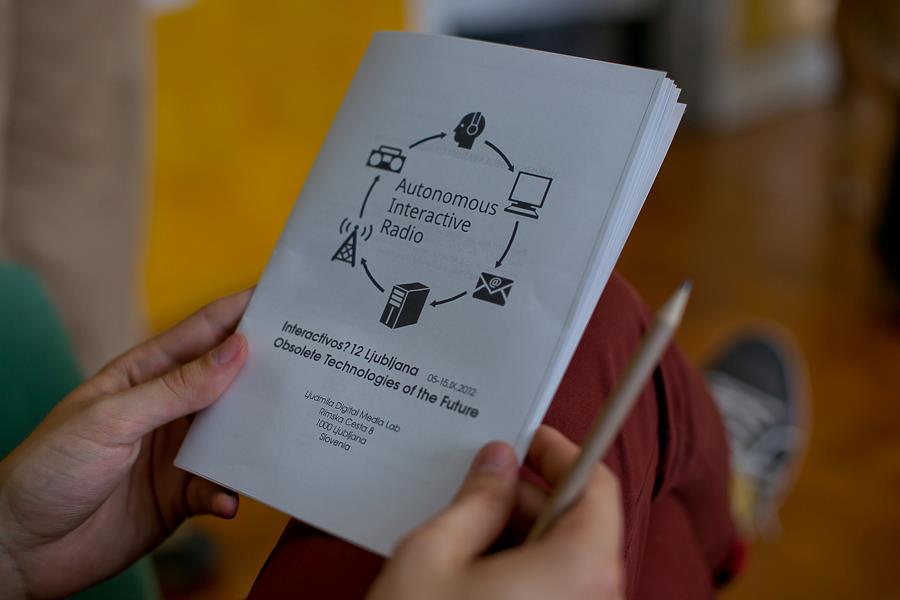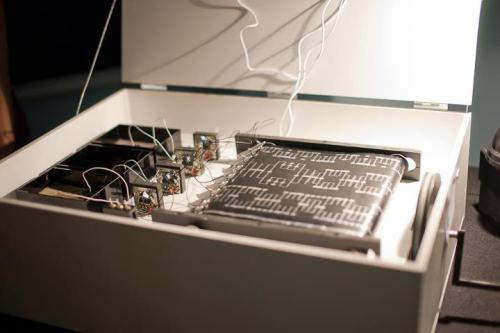Interactivos?'12 Ljubljana. Project Showcase

Mycophone
By Saša Spačal, Mirjan Švagelj and Anil Podgornik, Ljubljana (SL). Collaborators: Alberto Boem, Boštjan Bugarič, Neja Repinc, Gašper Odar, Jure repinc, Matic Urbanija.

Mycophone draws from the idea of a music box, hyper-nostalgic mechanical musical instrument, where synthesis of non biological (electronic and mechanic) and biologic organisms (mycelia) happens. Mycophone tries to combine a new biotech organism in a technological way and use the idea of nature in the most expanded way.
The use of mycelia is particularly interesting for its properties as the largest organism in the world, which can spread its communication range to remote places much like the Internet. For the music box this quality is specifically important because the complex network of mycelial colony signals a much more abrupt and measurable resistance than most other biological materials.
However, mycelia proved to have somewhat different characteristics. It is easily measured and its changes in resistance of the signal clearly detectable. It is also possible to detect and transform sounds if one pets it on its hairy mycelia furr, their sound/voice changes, almost as though one could hear it purr. As any other biological being it needs maintenance (turning the windup key) and care (peting) in order to develop its highest potential. But as any other organism it has patterns and repetitive processes, that have to be met for it to exists and to live. They are there to process the signal that has been put into it with the energy of turning the windup key. These patterns are seen as visual, graphical patterns on the laminate and heard as repetitive sound that is being transformed by the growth i.e. resistance of mycelia as well as proximity or observers' touch of a hand.
+ info at Studiolab Community
Domače Volt Orkester
By Matthew Gingold (AUS) and Ben Olsen (USA), Linz. Collaborators: Martina Kalogjera, Ivan Arroyo, Pepa Ivanova, Juan Duarte and Maja Kalogera.

Domače Volt Orkestra is about creating a live performance instrument, that is simultaneously an installation - and serves quite different cultural, historical and experiential gods. We are interested in is (re)animating -- or more precisely -- opening a window to the animism inside of objects, people and places. Domače Volt Orkestra does not breathe new life into old radio's, vacuum cleaners and tools. It simply misuses them. It directs there 'use', their capital and commercial productivity to a completely 'useless', and 'un'-valuable purpose. Namely making a live, low-verging-on-no-tech audio-visual experience.
It consists on a series of completely unrelated circuits and devices hacked together to make sound and vision. The final 'system' consists of the following unlikely combination of technologies: largely these can be divided into a radio section, a vacuum cleaner section, a white goods section and a tools section. There are also a few soloists - for instance the electric calculator and the shredder, the shaver and the pump. In total there are approximately 25 to 30 electric devices and 12-16 incandescent globes that comprise the final Orkestra. All the Members of the Orkestra are plugged into the Deathstars or N-1s which are plugged into the Arduinos, which are controlled by the DVOCS, which is being controlled by the collaborators and the Piezo's modulated some the resulting polycacophony.
+info at Studiolab Community
Autonomous Interactive Radio
By Reid Bingham and Sean McIntyre (US/CAN). Collaborators: Tomislav Butković, Helena Božič, Peter Pavlakis, Simon Gmamjer, Kruno Jošt and Rok Kovač.

As radio markets increasingly become corporate owned monocultures and governments slash funding to public radio, smaller communities and subcultures become underserved or cut out completely from this vital form of communication. Our project, AIR, seeks to address this problem by going smaller instead of bigger, focusing on creating a direct relationship between radio listener and radio station, turning the top down one way direction of traditional radio into a circle.
AIR, is an autonomous, neighborhood oriented, interactive, micro-radio station. The station consists of a low power radio transmitter and wifi enabled computer that is scripted to automatically download, queue, and then play, all audio files emailed to it. Files are played as they are downloaded by the station computer, and if multiple files are sent at once, they are queued in the order they are received. All files are added to a running playlist that is played and looped through continuously when no songs are being received. The content of this micro-radio station is based solely on the files people email to it. The queue system is set up to ensure a direct and immediate way to interact with AIR. With this project we wish to make radio a new space for neighborhood level interaction, expression, and experimentation.+info at Studiolab Community
Ophiodea
By Laura Olalde (ARG). Collaborators: Hector Zarate Rea, Jani Pirnat, Pepa Ivanova and Dan Adlešič.

The project consists of a compound eye based on multiple cells or lens inspired on the Ophiocoma wendtii organism. In this special kind of organisms, skin becomes a visual organ as well as tactile, as it is cover by light sensitive cells all over its surface. It uses a multi-camera system and a visualisation process resulting of the different images coming from different units. This sculptural object has organic characteristics and its surface has inserted lenses of six hacked cameras and that build the compound eye. These eyes also detect the movement of the visitors in the space. As surface is translucent, it is the screen in which we see the processed images coming from an inside projector, offering an unique and particular way of visualization.
The purpose of Ophidea interactive installation in relation to biomimicry is to explore the possibility of expanding our idea about the sensory perceptivity, which does not depend on visual and aural centricity that is the result not only of humans' biological predispositions but also by the culture that promotes visual and aural perceptivity above other senses like touch, smell, taste etc. It is also to question homocentric perception and empathize with simple creatures that have their sensual systems spread all over their skin.
+info at Studiolab Community
TeleVotón: An Automated Voting Machine
By Jasmina Morán (SP). Collaborators: Andrea Baima, Isac Petruzzi, Jure Repinc, Laia Ros and Héctor Zárate.
TeleVotón is intended as a reflection and a contribution to this complex global social transformation. It seeks to explore alternative and inclusive ways of thinking and making decisions to give power back to citizens. Due to the closure of bank offices, caused by the economic crisis and the concentration and nationalization of banks, thousands of ATMs have become obsolete in Europe. Therefore, it seems sensible that citizens could take advantage of these ATMs or even of the current ATMs network to make democracy more participative.
+info at Studiolab Community
Vicent, The Painter. Repurposing of Abandoned Printing Devices
By Gonzalo Ramírez Restucci(SP). Collaborators: Dragan Pijetlovic, James Stevens, Patric Kaufman, Urs Gaudenz and Igor Križanovskij.

Vincent the Painter considers the role of painters at the time when the material with which we construct our world and methods of representation is a software code. Vincent wants to stay as true to the painting process as possible while constructing a painting tool that fits the mind frame of contemporary visualiser.
When plotters are used in creating graphic images or paintings they mostly keep the horizontal surface, while Vincet mimics easel painting position. Potentially it will be able to use all sorts of painting materials like oil paintings, ink, watercolours, at the same time the most important addition is the possibility to write the code for visualisations in any of the programming environments for writing the codes (C++, Max, PureData, Processing etc) to enable different aesthetic and material qualities much like choosing the paints by a painter.
The essence of the work is first and foremost in the process that serves to demystify the alchemist process associated with painting, however the end product is likewise important. The beauty of the machine is that has the potential to draw generative network landscapes as well as mimicking reproductions of abstract expressionists.
+info at Studiolab Community



 Medialab-Matadero Madrid
Medialab-Matadero Madrid
